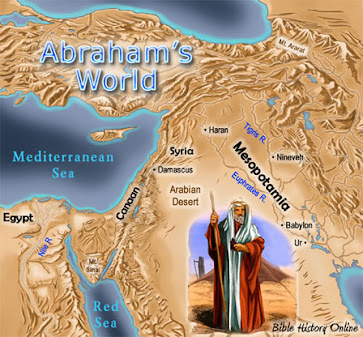Alice C. Linsley
The kinship structure of the early Hebrew ruler-priests indicates a hierarchy based on genetic distance. The ruler's proper heir is the offspring of siblings who had the same father but different mothers. (See Hebrew Ruler's with Two Wives.) Isaac was Abraham's proper heir as Sarah was Abraham's half-sister. Their father was Terah and their other siblings were Haran who died in Ur, and Nahor, Terah's first-born son by his sister bride and his proper heir. After Terah died in Haran (see map), Nahor ruled over Terah's territory in Aram. It was to that territory that Abraham's servant went to fetch a cousin bride for Isaac.
If Isaac adhered to the marriage and ascendancy pattern of his forebearers, Rebecca would have been his second wife. His first wife would have been a half-sister, a daughter born to Abraham and Keturah. That first wife would have been living in the Negev which is where Isaac was living before he married Rebecca.
Abraham became a sent-away son who eventually established himself in a territory that extended between Hebron and Beersheba. Isaac became the ruler over Abraham's territory and was a wealthy man.
Analysis of the kinship pattern of the early Hebrew rulers indicates segmentary lineages. The first loyalty is to the lineage of father and his principal (half-sister) wife and their son, the heir. The second loyalty is to the father and his second (cousin) wife and their son who belongs to the household of his maternal grandfather. The third loyalty is to the household and clan of the cousin.
A Bedouin proverb summarizes the philosophy behind segmentary lineages:
I against my brother
I and my brother against my cousin
I, my brother, and my cousin against the world
The next highest in rank is the first-born son of the cousin wife. This was probably Joktan/Jokshan, Abraham's first-born son by his cousin wife Keturah (Gen. 25). This son belonged to the household of his maternal grandfather. This first-born son often has the name of his maternal grandfather. This explains why two men separated by one generation have the same name. This is evident in the diagram of two rulers named Lamech.
Lamech the Elder had two wives. His daughter Naamah (Gen. 4) married her cousin Methuselah and named their first-born son Lamech, after her father (Gen. 5). This is called the cousin-bride's naming prerogative.
The first-born sons of concubines posed the potential for territorial expansion of the Hebrew. These sent-away sons drove the expansion of the Hebrew into many parts of the Ancient Near East and Southern Europe. Before he died, Abraham gave gifts/grants to the sons of his concubines and sent them away from Isaac (Gen. 25:6).
The dispersion of the Hebrew rulers began long before the time of Terah, however. Genesis 10 explains that Nimrod, a son of Kush, left the Nile Valley and established his territory in Mesopotamia which is where we meet Abraham nine generations later.
It appears that Eber divided his territory between two sons. Perhaps Peleg and Joktan were twins.
Analysis of the kinship pattern of the early Hebrew rulers indicates segmentary lineages. The first loyalty is to the lineage of father and his principal (half-sister) wife and their son, the heir. The second loyalty is to the father and his second (cousin) wife and their son who belongs to the household of his maternal grandfather. The third loyalty is to the household and clan of the cousin.
A Bedouin proverb summarizes the philosophy behind segmentary lineages:
I against my brother
I and my brother against my cousin
I, my brother, and my cousin against the world
Related reading: Royal Sons and Their Maternal Uncles; Sent-Away Sons; The Marriage and Ascendancy Pattern of Abraham's People; Isaac's Wealth; Hebrew Rulers with Two wives




No comments:
Post a Comment